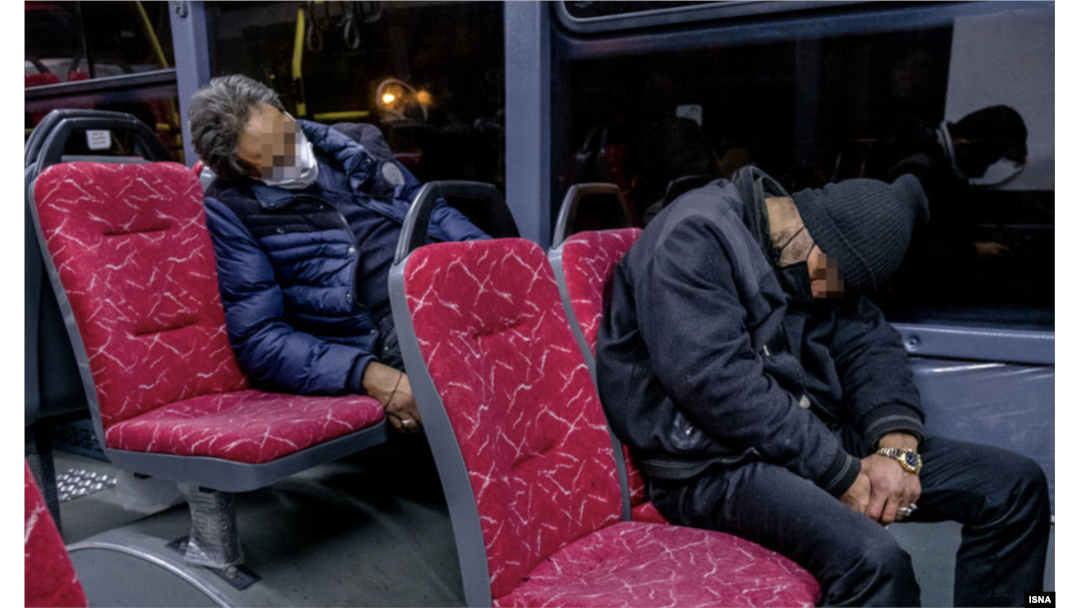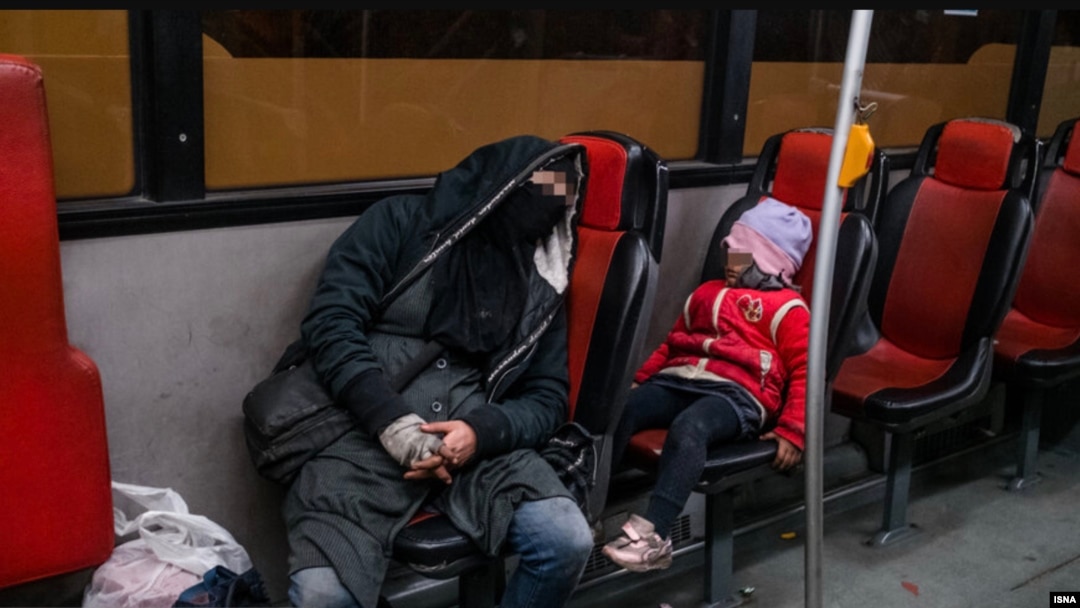A homeless mother and her young child sleep on a night bus as it weaves through the empty streets of the Iranian capital, Tehran.
The pair are among a growing number of Iranians who are resorting to sleeping in public buses out of economic desperation.
Photos of the mother and daughter have gone viral on social media, serving to highlight the deepening poverty in Iran, where the economy has been crippled by tough U.S. sanctions, the coronavirus pandemic, and years of mismanagement.
The plight of the "bus sleepers," as labelled by Iranian media, was first reported by Tehran-based trade publication Tejaratnews on December 29.
The outlet reported that many of them were residents with menial jobs. Unable to afford rent, they purchase tickets to the end of a bus line. During the hourslong journey, many take refuge from the winter cold and catch up on sleep. They usually get off the bus before the morning rush hour, the outlet reported.
According to Iranian media reports, the cost of rent in Tehran and its suburbs has jumped by around 50 percent in the past year. Those remaining in the capital spend between 60 and 70 percent of their income on housing, reports say.
"For them, a seat on the bus is like cheap accommodation in the capital. But even this cheap accommodation costs them between 360,000 and 750,000 tomans per month ($12 to $30)," Tejaratnews reported.
"During the day, each of them is busy [working] and at night they take refuge here," an unnamed bus driver told Tejaratnews. "Do not think that they're all [drug] addicts. Each of them has a job."

Cheaper than an apartment: two homeless Iranian men find refuge on public transport in Tehran.
The semiofficial ISNA news agency, which published images of the bus sleepers, reported that Tehran's public buses are the only safe places to sleep for many poor Iranians who make a living as laborers or street traders.
"The buses on these cold nights are full of homeless women, men, and even children who each have different stories," ISNA said.
The news agency claimed that many of those sleeping on buses have refused to go to shelters, calling them "unhygienic." Some reports also suggested there were not enough shelters for the growing number of homeless people in the city.
Downplaying The Issue
Photos and media reports about the bus sleepers have promoted reactions by Iranian officials, who have attempted to downplay the issue by saying many of them were drug addicts. Some officials have accused foreign-based, Persian-language media outlets of using the issue to spread "negative propaganda" about the country.
Mahmud Tarafo'e, the managing director of the Tehran Bus Company, claimed the issue was less widespread than reported.
"How can we tell if a [bus] traveler has a place to sleep or not?" he was quoted as saying by the state news agency IRNA on January 1. "We do not deny the existence of this phenomena, but it is a social and economic issue, and the Tehran Bus Company has no role in it. We have also seen in the past that drug addicts sleep in buses."
Homelessness in Iran has reportedly increased significantly in recent years as millions have been pushed into poverty.
But Ahmad Ahmadi Sadr, the managing director of the Welfare Organization of Tehran's Municipality, said that 20 buses in 20 different areas of Tehran had already been designated for the homeless to sleep in during this winter.
For his part, Mehdi Chamran, the head of Tehran's city council, quoted the mayor as saying that the bus sleepers will be relocated to an unspecified location. He did not provide further details.
"There are problems but whatever we do our work is being [misinterpreted]," he said on January 4. "We're being scrutinized by domestic and foreign media. Foreign news agencies have forgotten how garbage collectors live in [cities like] London or [in other] countries."
'A Time Bomb'
In an interview with RFE/RL's Radio Farda, Sweden-based sociologist Mehrdad Darvishpur accused Iranian authorities of attempting to diminish the importance of the issue. "Not only does it not help to resolve the issue, but this issue will keep growing and [become] a time bomb," he said.
Iranians have shared the images of the homeless sleeping in buses on social media while expressing concern over rising poverty in the country.
"This is Tehran," said Twitter user Vahid Jafari, who posted a video of people sleeping on a bus. "The poverty of the dear people of Iran increases every day."
"How can [one] not break by seeing these images?" journalist Elham Zohrevand wrote on Twitter while sharing the viral photo of the homeless mother and child sleeping in a bus.
Homelessness in Iran has increased significantly in recent years as millions have been pushed into poverty, according to observers. The exact number of homeless people in the Islamic republic is unknown.
Iranian media reports say that homeless people have resorted to sleeping in cardboard boxes, under bridges, or in cars.
In 2016, the daily Sharvand shocked the nation by publishing photos of homeless people sleeping in graves outside the capital.
Former lawmaker Ahmad Tavakoli, a member of Iran's powerful Expediency Council, a body that advises Supreme Leader Ayatollah Ali Khamenei, said last year that 60 percent of people in the country of some 84 million live under the poverty line.


